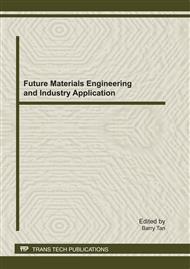[1]
C.Y. Lin, N. Kikuchi, and S.J. Hollister. A novel method for biomaterial scaffold internal architecture design to match bone elastic properties with desired porosity. Journal of Biomechanics. 37, 623–636, (2004).
DOI: 10.1016/j.jbiomech.2003.09.029
Google Scholar
[2]
J. Wei, J.F. Jia, F. Wu, S.C. Wei, H.J. Zhou, and H.B. Zhang. Hierarchically microporous/macroporous scaffold of magnesium–calcium phosphate for bone tissue regeneration. Biomaterials. Vol 31, 1260–1269, (2010).
DOI: 10.1016/j.biomaterials.2009.11.005
Google Scholar
[3]
H.W. Kim, S.Y. Lee, C.J. Bae, Y.J. Noh, H.E. Kim, H.M. Kim and J.S. Ko. Porous ZrO2 bone scaffold coated with hydroxyapatite with fluorapatite intermediate layer. Biomaterials. Vol 24, 3277–3284, (2003).
DOI: 10.1016/s0142-9612(03)00162-5
Google Scholar
[4]
X. Miao, Y. Hu, J. Liu and X. Huang. Hydroxyapatite coating on porous zirconia. Materials Science and Engineering. C27, 257-261, (2007).
DOI: 10.1016/j.msec.2006.03.009
Google Scholar
[5]
S.I.R. Esfahani, F. Tavangarian and R. Emadi. Nanostructured bioactive glass coating on porous hydroxyapatite scaffold for strength enhancement. Materials Letters. Vol 62, 3428–3430, (2008).
DOI: 10.1016/j.matlet.2008.02.061
Google Scholar
[6]
I.K. Jun, Y.H. Koh, S.H. Lee and H.E. Kim. Novel hydroxyapatite (HA) dual-scaffold with ultra-high porosity, high surface area, and compressive strength. Journal of Materials Science: Materials in Medicine. 18, 1071–1077, (2007).
DOI: 10.1007/s10856-007-0137-y
Google Scholar
[7]
C.T. Wu, Y.F. Zhang, Y.F. Zhu, T. Friis and Y. Xiao. Structure–property relationships of silk-modified mesoporous bioglass scaffolds. Biomaterials. 31, 3429–3438, (2010).
DOI: 10.1016/j.biomaterials.2010.01.061
Google Scholar
[8]
P. Barreiro, P. Rey, A. Souto and F. Guitián. Porous stabilized zirconia coatings on zircon using volatility diagrams. Journal of the European Ceramic Society. 29, 653–659, (2009).
DOI: 10.1016/j.jeurceramsoc.2008.07.018
Google Scholar
[9]
M.M. Pereira, A.E. Clark and L.L. Hench. Calcium phosphate formation on sol-gel-derived bioactive glasses in vitro. Journal of Biomedical Materials Research. 28(6), 693-698, (1994).
DOI: 10.1002/jbm.820280606
Google Scholar
[10]
Y.F. Zhu, C.T. Wu, Y. Ramaswamy, E. Kockrick, P. Simon, S. Kaskel and H. Zreiqat. Preparation, characterization and in vitro bioactivity of mesoporous bioactive glasses (MBGs) scaffolds for bone tissue engineering. Microporous and Mesoporous Materials. 112, 494–503, (2008).
DOI: 10.1016/j.micromeso.2007.10.029
Google Scholar
[11]
T. Kokubo and H. Takadama. How useful is SBF in predicting in vivo bone bioactivity? Biomaterials, 27(15), 2907–2915, (2006).
DOI: 10.1016/j.biomaterials.2006.01.017
Google Scholar
[12]
X. Qu, W.J. Cui, F. Yang, C.C. Min, H. Shen, J.Z. Bei and S.G. Wang. The effect of oxygen plasma pretreatment and incubation in modified simulated body fluids on the formation of bone-like apatite on poly(lactide-co-glycolide) (70/30). Biomaterials, 28, 9–18, (2007).
DOI: 10.1016/j.biomaterials.2006.08.024
Google Scholar
[13]
V. Karageorgiou and D. Kaplan. Porosity of 3D biomaterial scaffolds and osteogenesis. Biomaterials, 26, 5474–5491, (2005).
DOI: 10.1016/j.biomaterials.2005.02.002
Google Scholar
[14]
B.D. Boyan, T.W. Hummert, D.D. Dean and Z. Schwartz. Role of material surfaces in regulating bone and cartilage cell response. Biomaterials, 17(2), 137–146, (1996).
DOI: 10.1016/0142-9612(96)85758-9
Google Scholar


